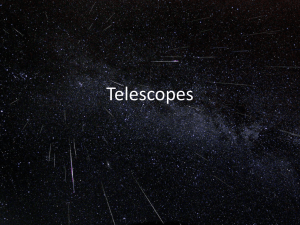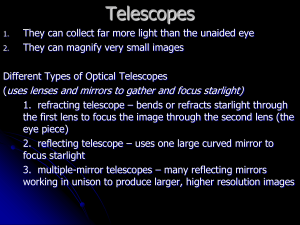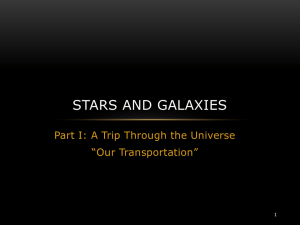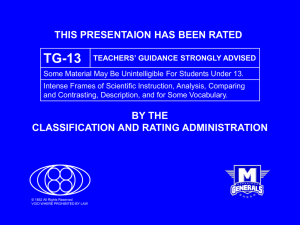here
advertisement
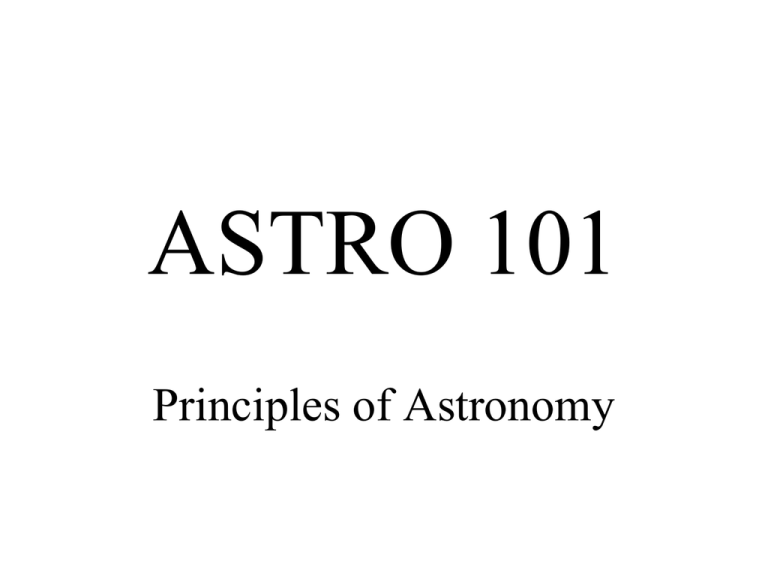
ASTRO 101 Principles of Astronomy Instructor: Jerome A. Orosz (rhymes with “boris”) Contact: • Telephone: 594-7118 • E-mail: jorosz@mail.sdsu.edu • WWW: http://mintaka.sdsu.edu/faculty/orosz/web/ • Office: Physics 241, hours T TH 3:30-5:00 Text: “Discovering the Essential Universe, Fifth Edition” by Neil F. Comins Course WWW Page http://mintaka.sdsu.edu/faculty/orosz/web/ast101_fall2013.html Note the underline: … ast101_fall2013.html … Also check out Nick Strobel’s Astronomy Notes: http://www.astronomynotes.com/ Homework • Homework due September 19: Question 4 from Chapter 3 (What are the three main functions of a telescope?) • Write down the answer on a sheet of paper and hand it in before the end of class on September 19. Homework • Go to a planetarium show in PA 209: • • • • • • • • The days and times of the shows will be (all shows last less than 1 hour): Thursday, September 5 : 5 PM Friday, September 6 : 2 PM Monday, September 9 : 1 PM and 5 PM Tuesday, September 10 : 1 PM and 5 PM Wednesday, September 11 : 5 PM Thursday, September 12 : 5 PM Friday, September 13 : 3 PM • Get 10 points extra credit for homework part of grade. • Sign up for a session outside PA 209. • Hand in a sheet of paper with your name and the data and time of the session. Coming Up • This week: Chapter 3 (Telescopes and light) • Tuesday, September 24: wrap-up, review • Thursday, September 26: Exam #1 Fall 2013 No appointment needed! Just drop by! Where: Room 215, physics-astronomy building (PA-215). When: All semester long, at the following days and times: • Monday: 12 – 2 PM; 5 – 6 PM • Tuesday: 12 – 2 PM; 5 – 6 PM • Wednesday: 12 – 2 PM; 5 – 6 PM • Thursday: 1 – 2 PM; 3 – 6 PM In the News… • http://www.latimes.com/science/sciencenow/la-sci-sn-harvest-moon-video20130918,0,525553.story • http://24timezones.com Coming Up: • The 4 forces of Nature • Energy and the conservation of energy • The nature of light – Waves and bundles of energy – Different types of light • Telescopes and detectors Light is a form of energy. Why is this important? With very few exceptions, the only way we have to study objects in Astronomy is via the light they emit. What is the nature of light? Light can be thought of as a wave in an electric field or as discrete particles of energy… What is the nature of light? Image from Nick Strobel’s Astronomy Notes (http://www.astronomynotes.com) Light can be thought of as a wave. The wavelength (usually denoted with a l) is the distance from crest to crest. What is the nature of light? Image from Nick Strobel’s Astronomy Notes (http://www.astronomynotes.com) Light can be thought of as a wave. The frequency (usually denoted with n) is the number of crests that pass a given point each second. What is the nature of light? Light can be thought of as a wave. The frequency (usually denoted with n) is the number of crests that pass a given point each second. What is the nature of light? The velocity of the wave is the wavelength times the frequency: The velocity of light in vacuum is constant for all wavelengths, regardless of the relative velocities of the observer and the light source. What is the nature of light? Image from Nick Strobel’s Astronomy Notes (http://www.astronomynotes.com) The above animation shows waves with different wavelengths moving with the same speed. Their frequencies are different. What is the nature of light? Light can be thought of as a wave in an electric field or as discrete particles of energy… What is the nature of light? Light can also behave like discrete particles called photons. The energy of a photon depends on the frequency (or equivalently the wavelength): The value of h is constant for all situations. What is the nature of light? Photons of higher energy have higher frequencies and shorter wavelengths, since Different “types” of light. What light can tell us. Visible light • White light is made up of different colors Visible light • Different colors correspond to different frequencies (or wavelengths). • The colors of the rainbow are ROY G BIV: red orange yellow green blue indigo violet. Visible light • In the visible, red has the longest wavelength, the smallest frequency, and the lowest energy. violet has the shortest wavelength, the highest frequency, and the highest energy. The Electromagnetic Spectrum • Visible light is only a tiny fraction of the Electromagnetic Spectrum. • For example, there is invisible radiation with wavelengths longer than red light that heats the thermometer. The Electromagnetic Spectrum • As we go to wavelengths slightly longer than visible (i.e. smaller frequencies and lower energies), we find infrared radiation, which is basically perceived as heat. • As we go to longer wavelengths still, we find microwave radiation, which is often used to pop popcorn. The Electromagnetic Spectrum • At the longest wavelengths, corresponding to the smallest frequencies and the lowest energies, we have radio waves, including AM/FM, shortwave, TV, etc. The Electromagnetic Spectrum • Visible light is only a tiny fraction of the Electromagnetic Spectrum. • If we go to shorter wavelengths (higher frequencies and energies), we find ultraviolet light. With higher energies, UV photons can damage skin cells. The Electromagnetic Spectrum • As we go even shorter in wavelength (higher in frequency and energy), we get Xrays. With their high energies, X-rays can be used to image our insides. • As the shortest wavelengths and the highest energies, we have gamma rays. Gamma rays are sometimes used to sterilize food. The Electromagnetic Spectrum • Visible light is only a tiny fraction of the Electromagnetic Spectrum. The Electromagnetic Spectrum • Gamma rays, X-rays, UV light, visible light, infrared radiation, microwaves, and radio waves are all different manifestations of electromagnetic energy. • The range in wavelengths typically encountered span a factor of 1014. • All forms of electromagnetic radiation travel with the same velocity. • The Earth’s atmosphere is transparent to visible light, some infrared, and the radio. It is opaque to UV, X-rays, and gamma rays. Coming Up: • The 4 forces of Nature • Energy and the conservation of energy • The nature of light – Waves and bundles of energy – Different types of light • Telescopes and detectors With very few exceptions, the only way we have to study objects in Astronomy is via the light they emit. So we need to collect photons, and detect them. Telescopes Telescopes • A flat surface reflects incident light at the same angle. • A curved surface can focus light. Telescopes • Glass alters the path of light. • A curved piece of glass can focus light. Telescopes • A telescope uses mirrors or lenses to collect and focus light. • The area of the lens or mirror can be considerably larger than the area of the eye’s pupil, hence much fainter objects can be seen. Telescopes • A refracting telescope uses a large lens to bring the light to a focus, as in Figure (a). • A reflecting telescope uses curved mirrors to bring the light to a focus, as in Figure (b). Telescopes • The largest lenses that can be built have a diameter of about 1m, and have very long focal lengths. • A lens must be held by its edges, and large lenses sag under their own weight. Also lots of light is lost in the glass. • For these and more reasons, all modern telescopes use mirrors. Telescopes • Using an objective mirror, plus some additional mirrors and lenses, light is collected and focused to a point. • This is a Newtonian telescope. Telescopes • Using an objective mirror, plus some additional mirrors and lenses, light is collected and focused to a point. • This is a Cassegrain telescope. Telescopes • A telescope’s main job is collecting photons. • The light gathering power is proportional to the area of the mirror or lens. The area of a circle is •If you double the diameter of the mirror, the light gathering power goes up 4 times. Telescopes • Modern mirrors can be made thin. Their shapes are maintained using pistons under computer control. • The Gemini telescope in Hawaii has primary mirror 8.1m in diameter. Telescopes • Modern mirrors can be made thin. Their shapes are maintained using pistons under computer control. • The Gemini telescope in Hawaii has primary mirror 8.1m in diameter. • These thin mirrors are cast in special rotating ovens. Telescopes • Mirrors can also be made out of smaller segments. • The Keck telescopes in Hawaii have primary mirrors 10m in diameter. What a Telescope Does • A Telescope is used to collect photons, so you can see fainter objects. Seeing Detail • What does the next line say? – If you can read this, thank a teacher. • Why is so hard to read? • Why do binoculars help? • It is hard to read because the angular size is small. The binoculars magnify the angular size. What a Telescope Does • A telescopes magnifies angular sizes. What a Telescope Does • A telescopes magnifies angular sizes and allows you to see more detail. Telescopes at other Wavelengths • Recall that there other forms of “light”, including radio waves, X-rays, UV light, etc. • The goal of “collect and detect” is still the same. • However, the technologies used to collect and detect are different at different wavelengths. Radio Telescopes • Radio telescopes use “mirrors” made from steel plates. • Radio receivers collect the focused radio waves. • The radio telescopes are huge because of the long wavelengths of the radio waves. Radio Telescopes • Radio telescopes use “mirrors” made from steel plates. • Radio receivers collect the focused radio waves. • The radio telescopes are huge because of the long wavelengths of the radio waves. Radio Telescopes • The GBT is the largest steerable radio telescope in the world, with a diameter of 100 meters. It is perhaps the largest movable land-based object in the world. Radio Telescopes • With modern computers and electronics, one can combine the signals from several radio telescopes to “synthesize” a much larger telescope. • The Earth’s atmosphere is transparent to visible light, some infrared, and the radio. • It is opaque to UV, X-rays, and gamma rays. To detect these wavelengths, one must go to space. X-ray Telescopes • For example, X-ray light cannot be reflected like visible light can. X-ray telescopes use “grazing incidence” mirrors to collect X-rays. Telescopes in Space • The Hubble Space Telescopes observes in the ultraviolet, visible, and infrared Telescopes in Space • The Hubble Space Telescopes observes in the ultraviolet, visible, and infrared. • It is also above the blurring atmosphere. Telescopes in Space • The Spitzer Space Telescopes observes in the infrared Telescopes in Space • The image on the left is at optical wavelengths, and the wavelength on the left is at infrared wavelengths. Different features are seen. Telescopes at other Wavelengths • For most wavelengths, you need to go into space to observe. Next: Light Detection Detection of Light • Once the telescope has collected the light, we need to detect the photons. • A typical detector will not record all of the incoming photons, i.e. the efficiency is less than 100%. • The observing efficiency is proportional to the product of the telescope area and the detection efficiency. Detection of Light • A bigger telescope gives a higher incoming photon rate. • A more efficient photon detector means more photons are recorded for a given incoming rate. Galileo Galilei (1564-1642) • Galileo was one of the first people to use a telescope to systematically study astronomical objects, starting in about 1609. • Galileo showed by observing the patterns of light and shadows that the moon had craters and mountains. • Galileo made very detailed drawings and notes. This page describes his observations of Jupiter and its 4 moons that he discovered. • Galileo observed spots on the Sun. He showed that the Sun rotates about once every 28 days. Disadvantages of the Eye. • Sometimes your eyes “play tricks” on you, i.e. you hallucinate. • It is hard to be quantitative about some things, for example how bright one star is compared to another. • Unless you are a good artist, it is difficult to share your observations. There is no direct permanent record. Photography • Certain light-sensitive chemicals (usually silver oxide) are placed on glass plates or on plastic film. • The chemicals are altered when exposed to light, the degree to which depends on the intensity of the light. • A chemical “development” process “freezes” the chemicals in their altered states, making a record of the image. • It is important to note that only about 5% of the exposed light is actually recorded on film. Lots of photons are simply “wasted.” Photography • Instead of your eye, put a camera on the telescope. There are some practical difficulties, as well as some advantages… A difficulty… • Stars move in the sky, they rise and set. If the telescope is not moving, the images appear streaked. • Fortunately, it is relatively easy to track the telescope. A difficulty… • The curvature of the tracks depend on where you look. …The Solution: • If you align one axis towards the celestial pole, then motion around that axis will “cancel” out the apparent motion caused by the rotation of the Earth. …The Solution: • The gears needed to track the telescope are visible near the top of the mount. • Most telescopes are so well balanced that they can be moved by hand, in spite of the fact that they can weigh several tons! Advantages of Photography • The film can be exposed over long periods of time, allowing one to collect more photons. • Example: your eye takes an “exposure” roughly 30 times per second. Suppose you exposed film for 30 seconds. During that time, your eye would have taken 900 exposures, erasing everything at the start of each one. Advantages of Photography • Example: your eye takes an “exposure” roughly 30 times per second. Suppose you exposed film for 30 seconds. During that time, your eye would have taken 900 exposures, erasing everything at the start of each one. • Thus a 30 second exposure could potentially detect 900 times more photons than you would have seen with your eye, neglecting the different efficiencies in detection (film is less sensitive than the eye). Advantages of Photography • A camera on a small telescope can easily be more effective than looking with the eye through a big telescope. History of Photography • Film (usually glass plates) was first used for astronomy. • In the late 1970s, digital cameras came into use. Digital cameras are more efficient at detecting light than photographic film. Photographic film detects about 5% of the incoming light, whereas digital cameras can detect well over 90% of the incoming light. Digital Photography • In the late 1970s, digital cameras came into use. Digital cameras are more efficient at detecting light than photographic film. Photographic film detects about 5% of the incoming light, whereas digital cameras can detect well over 90% of the incoming light. Digital Photography • Digital cameras are more efficient at detecting light than photographic film. Color Photography • Color information is obtained by placing various filters in front of the camera. Color Photography • The separate images are digitally processed to obtain the final color image. Color Photography Color Photography The faintest stars and galaxies in this picture are about one billion times fainter than the faintest stars you can see without a telescope.




